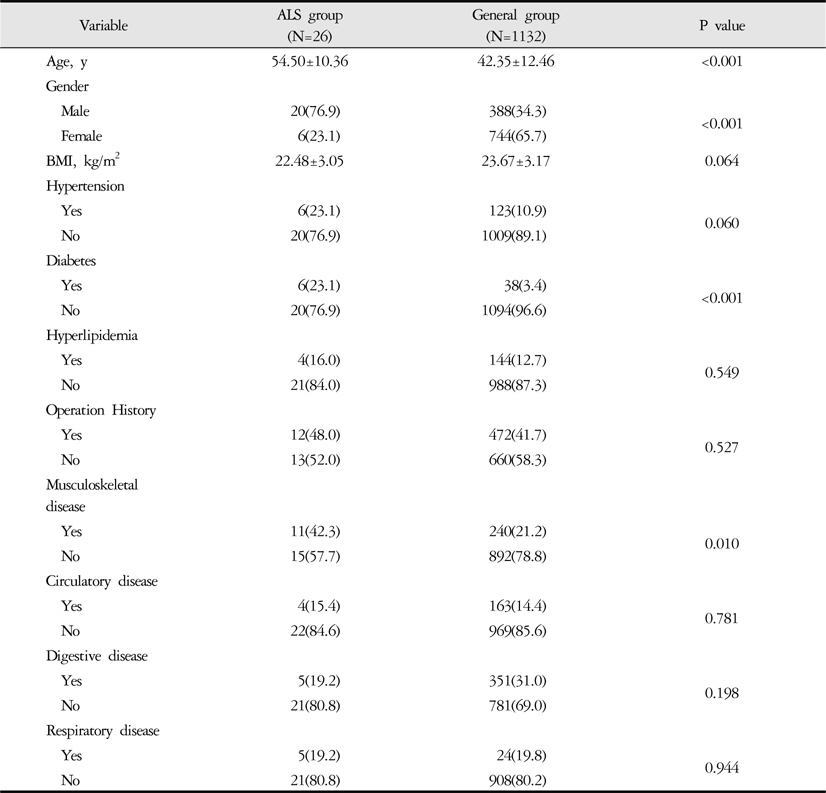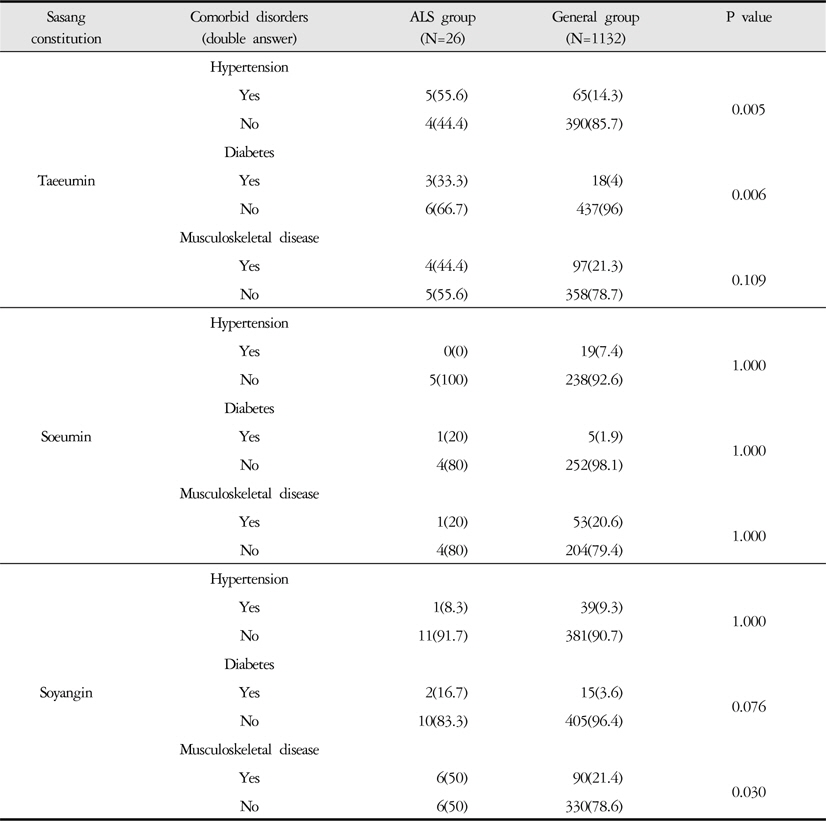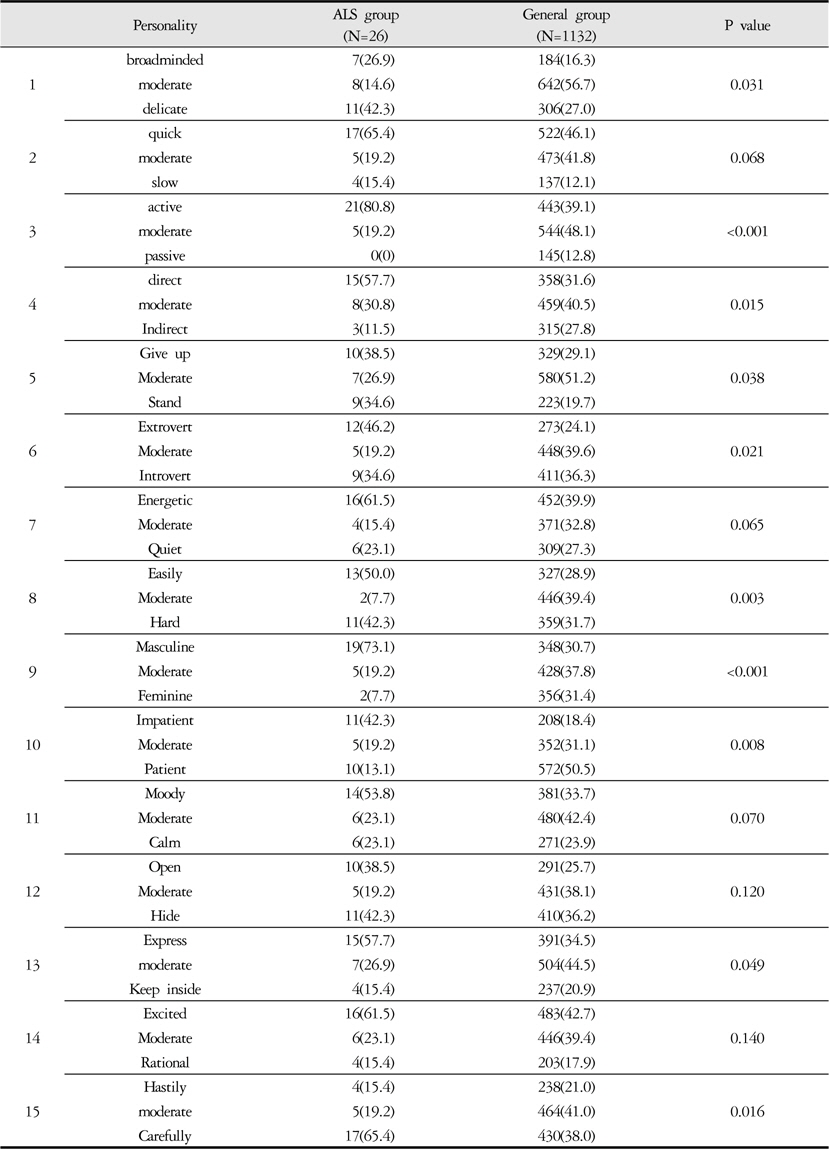



The purpose of this study was to analyze the Sasang constitution and psychological traits of amyotrophic lateral sclerosis (ALS) patients and to utilize the results in treatment and management.
The differences of Sasang Constitution distribution, psychological characteristics, comorbid disorders between ALS group of 26 patients and general group of 1132 persons were investigated and analyzed.
There was no significant different distribution of Sasang Constitution between ALS group and general group but there was Yang-like personality tendency in ALS group than general group. In overall constitution, ALS group had the high prevalence rate of musculoskeletal disorders and diabetes than general group. In Soyangin constitution, ALS group had a high prevalence rate of musculoskeletal disorders than genral group. In Taeeumin constitution, ALS group had a high prevalence rate of diabetes and hypertension than general group.
ALS patients have the Yang-like personality. It is due to the adaptation of personality on the environmental change or coping strategy on diseases rather than the characteristics of congenital Sasang Constitution.
근위축성측삭경화증(amyotrophic lateral sclerosis, ALS)은 운동피질, 뇌간, 척수의 운동신경원의 퇴행성 변화를 특징으로 하는 파괴적인 신경퇴행성 질환이다. 발병 이후 진행되어 발병일로부터 3-5년 이내에 호흡장애로 사망에 이른다. ALS의 원인은 밝혀지지 않았으며 효과적인 치료법도 없으나, 글루타메이트 길항제인 리루졸(riluzole)은 평균 2-3달 정도의 삶을 연장시킨다고 알려져 있다. ALS의 예후는 처음 증상이 발현된 나이가 적을수록, 첫 침범 부위가 사지형일수록, 처음 증상이 발병된 후 진단 받기까지의 시간이 길수록 좋다. 심리적 고통이 있는 환자는 안녕상태에 있는 환자들보다 사망할 위험이 높고, 기분이 저하되면 질병이 빠르게 진행된다. 따라서 ALS 환자의 심리 사회학적 특성을 파악하고 그에 맞는 심리적 대처 및 관리를 하는 것은 ALS 환자들의 예후에 매우 중요한 문제라고 할 수 있다1-4.
만성질환은 우울증의 위험요인으로 일관되게 보고되어 왔으며, 특히 알츠하이머병, 파킨슨병, 다발성경화증 등에서 우울증은 중요한 문제로 부각되고 있다. 만성 질환은 주된 치료 목적이 질환의 진행을 억제시키거나 증상을 완화시키는 것이므로 삶의 질이 특히 고려되어야 한다5-7. 그러나 ALS환자는 치명적인 예후에도 불구하고 적극적이며 감정적으로 균형을 이루고 있고, 일반적으로 우울증이 나타나지 않는다. 우울증이 나타나더라도 심각하지 않고 상대적으로 높고 안정적인 삶의 질을 유지하며, 질병의 진행에도 불구하고 크게 달라지지 않는다. 이러한 심리학적 특징은 질병 발생 이전의 타고난 성격 및 기질에서 기인한다는 의견, 대응기제에 의한 조절 및 보상작용에 의한 변화라는 의견, 신경퇴행에 의한 신경심리학적 변화라는 의견 등이 제시되고 있다8-14.
사상체질의학에서는 성정(性情)의 차이로 장국(臟局)의 차이가 발생하고 성격 특성 및 심리 유형이 달라진다고 보고 있다. 또한 최근에는 만성질환 및 정신질환의 유병률 및 다양한 특징에 대한 연구가 진행되고 있다15-17.
본 연구에서는 ALS환자의 주요한 예후 인자인 심리학적 특성을 이해하고자 ALS환자와 일반인간의 사상체질 분포, 성격 특성, 동반질환의 유병률의 차이를 조사하고 분석하였으며 유의한 결과가 있어 보고하게 되었다.
2012년 4월부터 6월까지 원광대학교 G한방병원 루게릭센터를 방문한 환자 중 El Escorial criteria(World Federation of Neurology, 1998)를 만족시키고, 근전도검사 및 생검을 통해 근위축성측삭경화증(amyotrophic lateral sclerosis, ALS)으로 진단받은 환자 26명과 원광대학교 J한방병원 건강증진센터에서 건강검진을 받은 일반인 1,132명을 대상으로 하였다(J-IRB-2012-0001).
1) 사상체질 진단
환자의 안면 특성, 체형 특성, 음성 특성, 설문 특성을 이용한 한국한의학연구원의 체질진단툴(Sasang Constitutional Analysis Tool, SCAT)의 결과를 참고하여 사상체질과 전문의가 최종 진단하였다.
2) 성격 측정도구
대범함/중간/섬세함, 적극적/중간/소극적, 외향적/중간/내성적, 남성적/중간/여성적 등 양적인 성향, 중간 성향, 음적인 성향 중 하나에 답하는 형식으로 구성된 15문항 설문지(저작물번호 제c-2009-002439호)로 Cronbach's α는 0.801이었다18.
통계프로그램은 SPSS 20.0 for Windows를 사용하였으며, t-test, ANOVA, Chi-square test, Fisher's exact test에 의해 두 그룹간의 차이를 검정하였다. 유의수준은 0.05로 하였다.
근위축성측삭경화증(amyotrophic lateral sclerosis, ALS)환자군의 연령은 54.50±10.36세로 49세이하가 5명(19.20%), 50세 이상이 21명(80.80%)이었으며, 일반인군의 연령은 42.35±12.46세로 49세 이하가 756명(69.5%), 50세 이상이 332명(30.5%)이었다(p<0.001). ALS환자군의 남자는 20명(76.9%), 여자는 6명(23.1%)이었으며, 일반인군의 남자는 388명(34.3%), 여자는 744명(65.7%)이었다(p<0.001). ALS환자군의 체질량 지수는 22.48±3.05kg/m2이었으며, 일반인군의 체질량 지수는 23.67±3.17kg/m2이었다(p=0.064). 동반질환의 경우 당뇨병은 ALS환자군 6명(23.1%), 일반인군 38명(3.4%)이었으며(p<0.001), 근골격계질환은 ALS환자군 11명(42.3%) 일반인군 240명(21.2%)으로 차이가 있었으며(p=0.010), 고혈압, 고지혈증, 순환기질환, 소화기질환, 호흡기질환 등의 동반질환과 수술경험 유무는 두 집단간 차이는 없었다 (Table 1).
[Table 1.] General Characteristics of ALS Group and General Group

General Characteristics of ALS Group and General Group
ALS환자군의 사상체질 분포는 소양인 12명(46.2%), 태음인 9명(34.6%), 소음인 5명(19.2%)으로 소양인이 가장 많았으며, 일반인군은 소양인 420명(37.1%), 태음인 455명(40.2%), 소음인 257명(22.7%)으로 태음인이 가장 많았으나 두 집단간 차이는 없었다 (Table 2).
[Table 2.] Distribution of Sasang Constitution between ALS Group and General Group

Distribution of Sasang Constitution between ALS Group and General Group
ALS환자군의 증상이 처음 나타난 연령은 소양인 49.25±14.79세, 태음인 51.50±7.64세, 소음인 51.20± 6.02세이었으며, 처음 진단받은 연령은 소양인 51.00±14.82세, 태음인 52.63±8.23세, 소음인 52.80±5.07세로 두 연령값 모두 체질간 차이는 없었으며, 발병부터 진단까지의 기간 또한 체질간 차이는 없었다. 증상 첫 침범부위는 전체 ALS환자 26명 중 사지형 21명(80.8%), 연수형 5명(19.2%)으로 사지형의 비율이 높았으며, 증상 첫 침범부위를 체질에 따라 살펴보면 소양인 ALS환자 12명 중 사지형 9명(75%), 연수형 3명(25%), 태음인 ALS환자 9명 중 사지형 8명(88.9%), 연수형 1명(11.1%), 소음인 ALS환자 5명 중 사지형 4명(80%), 연수형 1명(20%)으로 모든 체질에서 사지형의 비율이 높았으며 체질간 차이는 없었다(p=0.819)(Table 3).
[Table 3.] Clinical Profile of ALS according to Sasang Constitution

Clinical Profile of ALS according to Sasang Constitution
동일한 체질에서의 동반질환은 태음인 ALS환자의 고혈압 유병률이 55.6%로 태음인 일반인 14.3%에 비해 높았으며(p=0.005), 당뇨병 유병률도 33.3%로 4.0%에 비해 높았으며(p=0.006), 소양인 ALS환자의 근골격계질환 유병률은 50.0%로 소양인 일반인의 21.4%에 비해 높았다(p=0.030) (Table 4).

Comorbid Disorders according to Sasang Constitution between of ALS Group and General Group
성격은 대범함/중간/섬세함(p=0.031), 적극적/중간/소극적(p<0.001), 표현직접적/중간/표현간접적(p=0.015), 포기빠름/중간/포기느림(p=0.038), 외향적/중간/내성적(p=0.021), 결정쉽게/중간/결정어렵게(p=0.003), 남성적/중간/여성적(p<0.001), 참을성부족/중간/잘참음(p=0.008) 의견표현잘하는편/중간/의견표현안하는편(p=0.049), 덜렁거림/중간/꼼꼼함(p=0.016)등에서 ALS환자군과 일반인군간에 차이가 있었는데, ALS환자군은 섬세함, 적극적, 표현직접적, 포기빠름, 외향적, 결정쉽게, 남성적, 참을성부족, 의견표현잘하는편, 꼼꼼함 등에 응답한 비율이 높았다 (Table 5).
[Table 5.] Personality Differences between ALS Group and General Group

Personality Differences between ALS Group and General Group
동일한 체질에서의 성격은 소양인은 대범함/중간/섬세(p=0.049), 적극적/중간/소극적(p=0.015), 직접적/중간/간접적(p=0.024), 남성적/중간/여성적(p=0.001), 덜렁거림/중간/꼼꼼함(p=0.049) 등에서 ALS환자군과 일반인군간에 차이가 있었는데, 소양인 ALS환자군은 섬세함, 적극적, 표현직접, 남성적, 꼼꼼함 등에 응답한 비율이 높았다. 소음인은 대범함/중간/섬세함(p=0.009), 포기빠름/중간/포기느림(p=0.009), 참을성부족/중간/잘참음(p=0.008), 속잘드러냄/중간/안드러냄(p=0.032), 의견표현잘하는편/중간/의견표현안하는편(p=0.005) 등의 항목에서 차이가 있었는데, 소음인 ALS환자군은 섬세함, 포기느림, 참을성부족, 속잘드러냄, 의견표현잘하는편 등에 응답한 비율이 높았다. 태음인은 행동빠름/중간/행동느림(p=0.019)의 항목에서 차이가 있었는데, 태음인 ALS환자군은 행동빠름에 응답한 비율이 높았다(data not shown).
근위축성측삭경화증(amyotrophic lateral sclerosis, ALS)환자의 성격은 독립적이며, 내적 통제를 잘 하며, 능동적으로 극복하려는 자세를 가지고 있다. 또한 질환의 말기에 호흡능력이 떨어지는 유사 질환의 환자에 비해 심리적인 어려움을 덜 겪는다. ALS환자의 우울증에 관한 최근 연구에서 ALS환자의 우울증은 일시적이며, 심각한 경우는 드물며, 죽음에 가까워지더라도 증가하지는 않는다고 하였다19-21. 즉 ALS환자는 다른 질환에 비해 우울증에 이환되지 않는 경향을 가졌거나, 우울증을 잘 극복하는 성격을 가졌다고 생각해볼 수 있으며, 이 점은 사상체질과의 연관성에 대해 연구해 볼 가치가 있다고 할 수 있다. 본 연구에서 ALS환자군의 사상체질 분포는 소양인이 가장 많았으나 일반인군의 분포와 유의한 차이는 없었다. 처음 증상이 발현된 나이, 증상 첫 침범부위, 처음 증상이 발현된 후 진단받기까지의 기간 등에 있어서도 사상 체질별 차이는 없었다.
본 연구에서 대부분의 ALS환자는 적극적, 외향적, 남성적인 성격 경향성을 가지고 있으며, 참을성이 부족하고 포기가 빠르며 결정을 쉽게 하고 표현이 직접적이며 자신의 의견을 잘 표현하는 양적인 성격의 경향을 보였다. 일반인군이 중간의 성격 성향을 선택하는 경우가 많은데 비해 ALS환자는 성격 특성이 양적 또는 음적 한편으로 치우치는 경향을 보였다. 체질 분포는 차이가 없으나 성격에서 차이가 있다는 것은 우울증을 잘 극복하거나, 양적 성격 경향성을 가진 심리학적 특성이 질병 전의 환경 변화에 따라 성격이 변한 것이거나, 질병의 발생 이후에 나타나는 대응기제로 인한 것으로 생각할 수 있다.
동일한 사상체질내에서의 ALS환자와 일반인의 성격을 살펴본 결과에서 소양인에서는 ALS환자가 일반인보다 적극적, 남성적, 표현을 직접적으로 하는 성격을 가지고 있었으며, 소음인에서는 ALS환자가 일반인보다 참을성이 부족하며, 자신의 의견을 잘 표현하며, 속을 잘 드러내는 등 양적인 성격을 가지고 있었다. 그러나 소양인과 소음인 모두 통계분석 결과에서는 두 집단간의 샘플수의 차이로 인하여 유의성은 확보하지 못하였으나 두 체질 모두 ALS환자는 양적 성격 특성을 보인다는 점을 알 수 있었다.
전체 환자를 대상으로 분석한 동반질환 결과에서 당뇨병과 근골격계질환의 유병율은 ALS환자가 일반인에 비해 높았으며, 체질별 분석에서는 근골격계질환의 경우 소양인 그룹에서만 ALS환자의 유병률이 일반인보다 높았으며, 당뇨병과 고혈압의 경우 태음인 그룹에서만 ALS환자의 유병율이 일반인보다 높았다. ALS환자들은 일반적으로 ALS로 확진되기 전에 근력의 약화가 나타나면 경추 및 요추의 척추증으로 진단되어 척수감압술을 시행하는 경우가 있는데 시행후에도 근력이 회복되지 않거나 회복되더라도 경미한 호전에 그치는 경우가 많다22. 즉 근골격계질환의 절대적인 유병률이 높다기보다 ALS의 초기 증상이 다른 질환으로 진단되어 상대적인 유병률이 높아진 것으로 생각할 수 있다. 이는 근력의 약화를 호소하는 환자들 특히 소양인은 방사선 소견상 척추증이나 신경근 손상의 증거가 있더라도 ALS의 가능성을 고려할 필요가 있다는 것을 시사한다. 태음인 ALS그룹의 높은 당뇨병유병율은 ALS 모델 동물 연구에서 당뇨 및 내당능장애로 발생한 활성산소가 당독성 또는 신경 염증 등의 기전으로 ALS를 발생시키거나 진행시킨다는 이전연구로 볼 때 당뇨병이 있는 태음인이 ALS의 발병 및 진행의 위험에 더 노출될 가능성이 높다고 추정할 수 있으나, 정확한 기전이나 원인은 추후 연구에 의해 밝혀져야 할 것이다23-24. 고혈압은 일반적으로 ALS 발생의 위험요소이며, ALS의 예후를 불량하게 진행시킬 수 있는데, 특히 만성 고혈압은 비정상적인 뇌의 관류를 일으켜 운동신경원에 산소와 당의 수요와 공급의 부조화를 일으키며 신경 퇴행을 나타나게 한다. 그러나 ALS의 증상이 발현되기 직전 발견된 최근의 고혈압은 오히려 저산소증에 대한 보상작용으로 동맥혈압을 증가시킬 수 있으며 생존에 영향을 끼치지 않는다. 본 연구 결과에서 태음인 ALS그룹에서만 고혈압 유병율이 높게 나타난 것은 두 그룹간의 특성에 대한 고려가 이루어지지 않았기 때문으로 추정되며, 추후 연구에서 성별, 연령, 체질량지수, 고혈압 진단 시기 등을 고려한 후 ALS와 고혈압, 체질과의 관계를 살펴본다면 이전의 연구와 유사한 결과가 나올 것으로 생각할 수 있다25-30.
결론적으로 ALS환자의 양적 성향의 심리학적 경향성은 선천적으로 규정되거나 사상체질에 따른 차이라기보다는 환경의 변화로 인한 성격의 변화 또는 질병에 대한 대응기제에서 기인하는 것으로 볼 수 있다. 따라서 ALS환자의 심리학적 치료 및 대책에 이러한 내용이 고려되어야 할 것이다.
본 연구의 한계로는 ALS환자군의 숫자가 적은 점, 병원을 직접 방문한 환자를 대상으로 한 점, 증상의 중증도에 대한 고려가 없었다는 점, 그룹간에 연령이나 성별, 사상체질 등의 균등한 분포가 이루어지지 못한 점 등이 있겠다. 이러한 한계를 고려하여 보강된 추후 연구가 필요할 것으로 사료된다.




